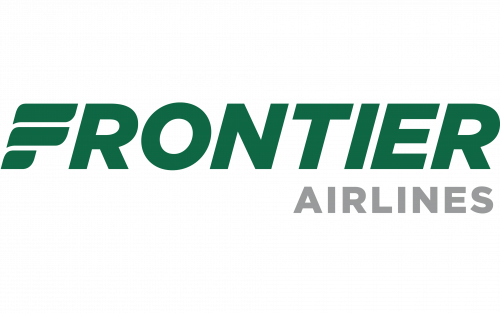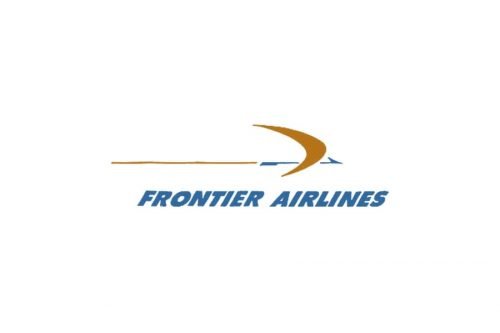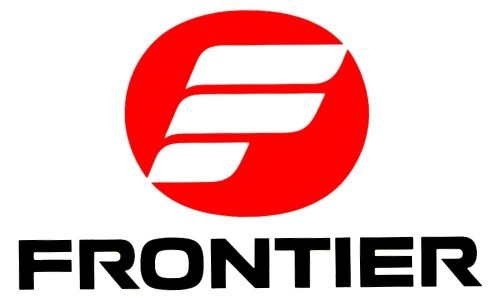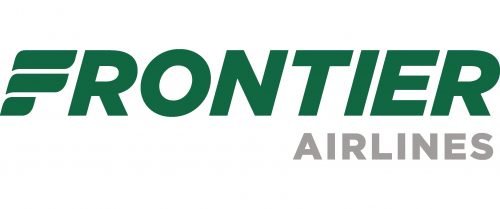The current Frontier Airlines logo was unveiled in the fall of 2014. It looks like an italicized and slightly watered-down version of its predecessor. More importantly, it features the iconic “F” from the emblem created in 1978 by Saul Bass. Although the letter is now green instead of red, it creates a link with the former airline and also gives the design a truly unique touch.
Meaning and history
Original Frontier Airlines (1950 – 1986)

Frontier Airlines, the predecessor of the today known air carrier from the United States, was established in the beginning of the 1950s, as a result of a merger of three other airlines — Arizona Airways, Monarch Airlines, and Challenger Airlines. The company existed until 1985, operating flights exclusively across the United States.
What is Frontier Airlines?
Frontier Airlines is an American airline founded in 1994 and headquartered in Denver. The target audience is middle class Americans, as the company provides its customers with cheap tickets. Flights are made to 83 locations, which are not only in the United States, but also in Mexico and Costa Rica.
1958
The older Frontier Airlines logo featured a stylized emblem that could be interpreted as an arrow and a bow or as a plane. The emblem looked very dynamic, as did the lettering below. The lettering featured the words “Frontier Airlines” in an italicized sans.
The palette, which combined gold and dark blue, was apparently inspired by the colors of the sun and sky.
1978
Both the original and the final logos were developed by Saul Bass, a US graphic designer and Oscar-winning filmmaker, who worked for such popular filmmakers as Alfred Hitchcock, Billy Wilder, and Stanley Kubrick, to name just a few. He was also the author of some of the best-known airline industry logos, including the Continental Airlines jet stream emblem and the United Airlines tulip emblem.
The 1978 logo was completely different from its predecessor. It featured a stylized “F” in white inside of a red circle. The “F” was made up of three horizontal bars with curved ends.
Below the “F,” there was the black lettering “Frontier” in a sans serif type with very distinctive “R’s.” While the overall style of the typeface was utterly different from that used for the emblem above, the two bars on the “F” also had equal lengths.
The original airlines were closed in 1986 following the merger with Continental Airlines.
New Frontier Airlines

The new Frontier Airlines was founded in 1994 and is the reincarnation of another airline of the same name that went bankrupt in the 1980s.
In 2004, the first regular flights by Boeing 737 began. Flights were operated from Denver on routes throughout the United States. The young airline became quite a strong competitor to United Airlines due to low fares.
In 2006 the airline underwent a major reorganization of all its activities. Frontier Airlines Holdings, Inc. was created, which was registered in the state of Delaware (the state government provided the airline with tax benefits). In November 2006, Frontier Airlines began a partnership with another major U.S. airline, AirTran Airways, consisting of mutual use of loyalty programs and customer exchanges (where possible).
In early 2007, Frontier Airlines announced a partnership with another regional airline, Republic Airlines.
1994
The eighth-largest commercial airline in the US commenced operations in 1994. Their first two logos were completely different from those of the defunct company working under the same name.
The 1994 Frontier Airlines logo featured the word “Frontier” in a creative type inspired by handwriting. It was not a calligraphic script but rather a casual, relaxed one. The word “Airlines” in an austere sans could be seen below.
The writing was white over the dark and dusty blue background.
2001
While the previous logo was pretty distinctive, legibility was not among its strengths. The problem was resolved in 2001.
To begin with, the handwritten script in the word “Frontier” was replaced by a highly legible, bold sans. Also, the word “Airlines” grew large and better-visible. It was now black on the white background, which added some contrast and also improved the legibility.
While the logo has grown more legible, it did not look distinctive and meaningful.
2014
This version is already more distinctive and more dynamic, which in a way hints at the fact it belongs to an airline.
To begin with, the company has borrowed the “Flying F” from its predecessor and has included it as the initial in its own name. The type has been italicized, which added some motion. The distance between the letters in the word “Airlines” has grown smaller, which made the word easier to grasp.
The new palette can be described as dustier (grayer) or watered-down in comparison with the previous one.
Font and Color
The bold uppercase lettering from the primary logo of the Frontier airlines is set in the italicized geometric sans-serif typeface, which looks simple yet strong and progressive. The closest fonts to the one, used in this insignia, are, probably, Integral CF Demi Bold Oblique, or Aktifo Aktifo A Black Oblique.
As for the color palette of the Frontier visual identity, it is based on a combination of green and gray, which is a pretty rare scheme for an air carrier, and this is what makes the company stand out in the list of its competitors. Green is a symbol of growth and development, while gray stands for stability and quality.
Author of the heritage “F” emblem
Saul Bass was best known for his design of motion-picture title sequences, film posters, and logotypes. The list of filmmakers with whom he worked included Alfred Hitchcock and Martin Scorsese, to name just a few. He was the author of the Bell System logo (1969) and the AT&T’s globe logo (1983).













